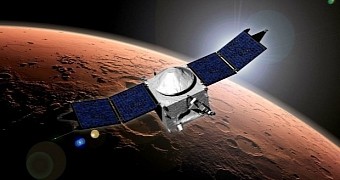In September 2014, NASA's MAVEN spacecraft finally reached Mars and placed itself in its orbit. The probe, launched back in November 2013, has been circling the Red Planet ever since.
Mission scientists explain that, most of the time, the MAVEN spacecraft hovers over its target planet at an altitude between 150 kilometers and 6,200 miles (93 miles and 3,853 miles).
Earlier this month, the probe was at long last given permission to move closer to Mars than ever before. Thus, NASA researchers say that, between February 10 and 18, MAVEN was lowered to an altitude of 125 kilometers (78 miles).
Why make a big fuss over this altitude difference?
Truth be told, having MAVEN orbit Mars at an altitude of 125 kilometers (78 miles) instead of 150 kilometers (93 miles) does not sound all that impressive. After all, we're talking about an altitude difference of just 25 kilometers (16 miles).
Still, scientists explain that, at 125 kilometers (78 miles) above the Red Planet's surface, the local atmospheric density is about ten times greater than at an altitude of 150 kilometers (93 miles).
What this means is that, during the so-called deep-dip maneuver it successfully completed earlier this month, NASA's MAVEN spacecraft got to have an unprecedented look at the lower end of Mars' upper atmosphere and collect data concerning its makeup.
To make sure this little adventure would not damage it, the probe was not simply allowed to plunge towards the Red Planet's surface. Instead, the spacecraft was lowered to the desired altitude by firing its engines on three separate occasions over the course of three days.
Having completed about 20 orbits at this new altitude, the MAVEN probe was sent back to its usual spot. To successfully return the spacecraft to its usual science operation altitude, NASA scientists had to fire its engines twice.
What is MAVEN doing on Mars anyway?
This NASA spacecraft was sent to the Red Planet in an attempt to gain a better understanding of the atmosphere surrounding this cosmic neighbor of hours. The goal is to determine how this atmosphere has changed over the years and how it influences climate conditions on Mars.
To this end, the space probe is expected to complete a total of five deep-dip maneuvers like the one it performed this February. Mission scientists explain that, during these campaigns, MAVEN will collect data concerning both the makeup and the dynamics of Mars' atmosphere.
“MAVEN is studying the entire region from the top of the upper atmosphere all the way down to the lower atmosphere so that the connections between these regions can be understood,” NASA researchers explain.

 14 DAY TRIAL //
14 DAY TRIAL //